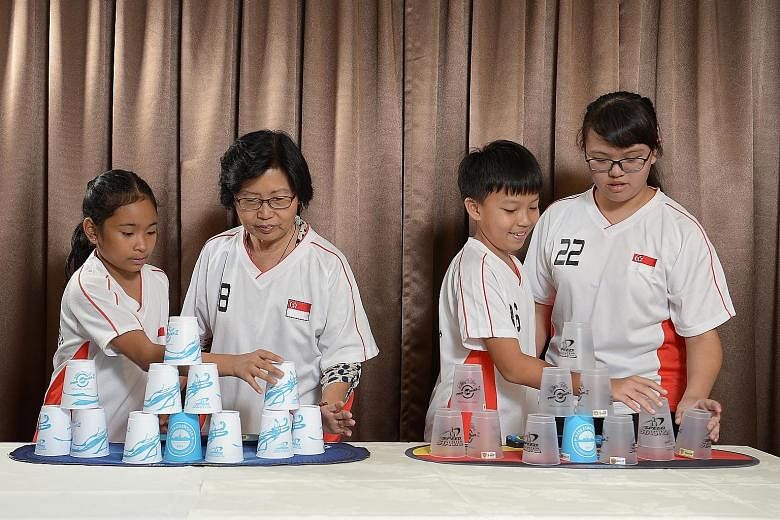Hai Sing Catholic School student Winnie Hiew, 15, kept her love for sport stacking under wraps when she first started two years ago.
"I didn't want to tell my friends, in case they thought I was weird," she said. "Everyone's outside playing badminton and basketball, and I'm here stacking cups."
Her passion and hard work eventually earned her three overall national sport stacking records for the female division.
Sport stacking, also known as cup stacking or speed stacking, requires participants to stack and unstack cups in various specific formations as fast as possible.
The idea came from a Mr Wayne Godinet from California in the early 1980s, and it was popularised in the 1990s. The World Sport Stacking Association (WSSA), based in Colorado in the US, was formed in 2001 to promote and govern sport stacking around the world.
The Singapore branch of the association was founded in 2008 and is now headed by Mr Allan Ong, 41.
There are about 3,000 stackers in Singapore, but only 250 who stack competitively under the banner of Team Singapore, estimates Mr Ong, who runs the Singapore branch full-time. Stackers come from all age groups, from as young as five to as old as mid-60s.
Over the years, Team Singapore has accomplished several notable feats. It holds five divisional world records, one by nine-year-old Shaina Nero Ruiz. Special stackers - those with physical or intellectual disabilities - have set four world records. Twelve-year-old Ikhsan Irwan is one of them. He holds world records for all individual competitive sequences in the Level One Special Stackers Age 11-14 division.
Stacking is gaining traction in Singapore, according to Mr Ong.
More than five schools have contacted WSSA Singapore for information about stacking so far this year, more than double the number in the same period last year.
St Stephen's School has been holding cup stacking sessions regularly during recess since August last year, when some play areas were hoarded up for upgrading.
The principal of the primary school, Mr Thomas Koh, told The Straits Times it became so popular that the school held a competition early this year, in which over half the pupil population participated.
"Cup stacking was chosen because it can be played by all ages and within the school canteen," said Mr Koh.
WSSA Singapore's Mr Ong said about 10 community centres run regular sessions on cup stacking.
In 2011, Singapore held a major competition, the Asian Open, that was attended by seven countries.
The Singapore Open will be held on June 4 and 5 at the Orchid Country Club. So far, about 100 Singaporeans are participating, as well as about 80 competitors from countries and territories including Malaysia, the Philippines and Taiwan.
More children in Singapore are taking up stacking, compared to two years ago, when most of the stackers were senior citizens, said Mr Ong.
Parents whose children are into stacking find it a good way to bond with them. Winnie's mother, Ms Serene Ong, 39, volunteers at some of the stacking competitions her daughter took part in. She even participates in the Parents' Doubles, where a parent and child each uses one hand to stack together.
"We talk and interact more now," said Ms Ong, a secretary in the semiconductor industry.
Ms Jane Sim, 35, whose son Edison Chew, 11, is a competitive stacker, said: "We discuss strategies to improve our timings. We have a common goal."
Ms Sim, a naval engineer, noticed a change in her son, who goes to Jing Shan Primary School. "He used to be able to focus for 10 minutes (when he studies)... Now, he can focus for over 30 minutes," she said.
According to recent studies by Texas Tech University and Mesa State College in the US, sport stacking improves concentration and hand-eye coordination, and utilises both the right brain and left brain. It also improves bilateral coordination, the ability to use both sides of the body at the same time in an organised manner.
Edison and Winnie stack with their friends regularly now, and hope that more schools will offer it as a co-curricular activity.
Said Winnie: "Some people don't see it as a sport... (but) I hope stacking can become as popular as other more common sports."

